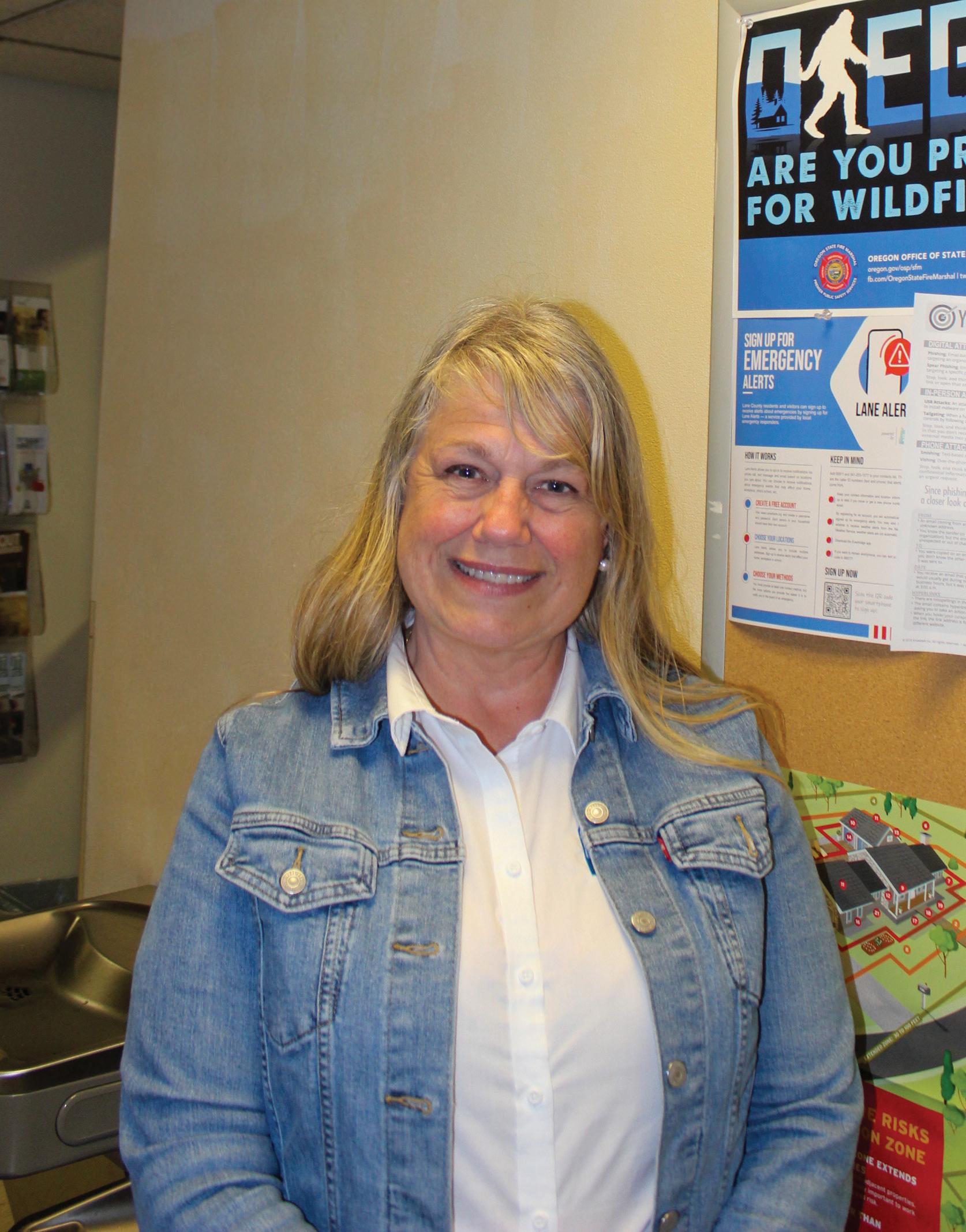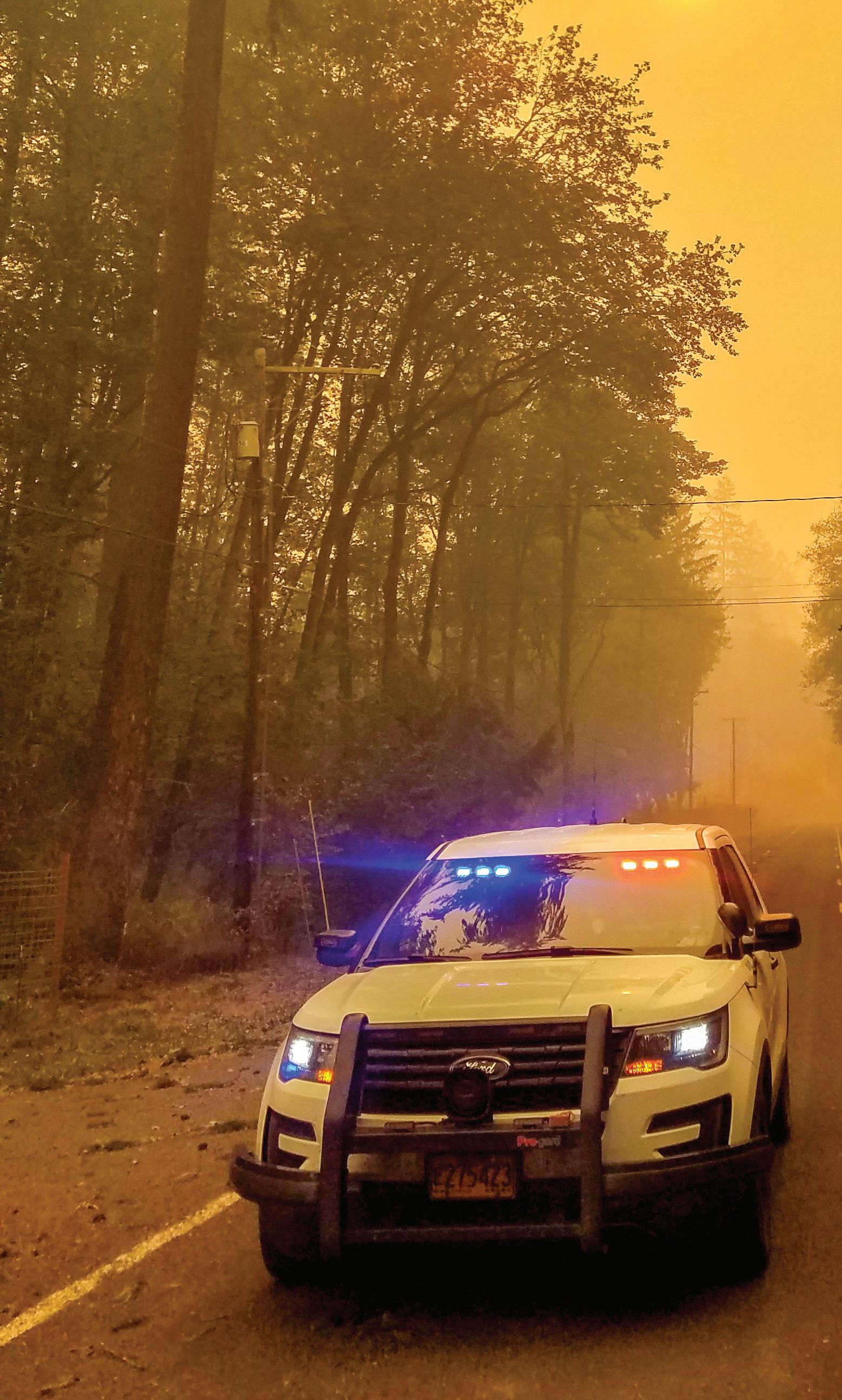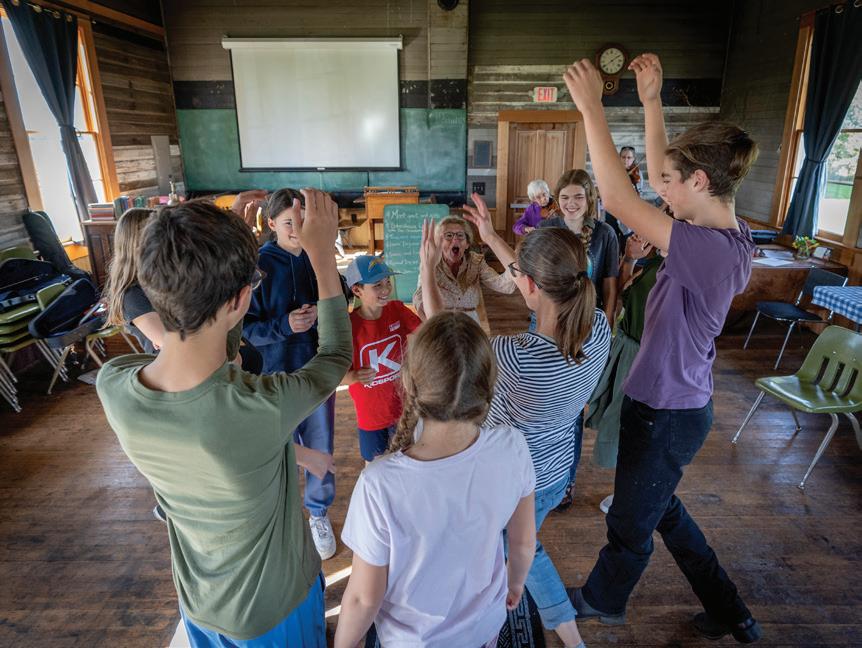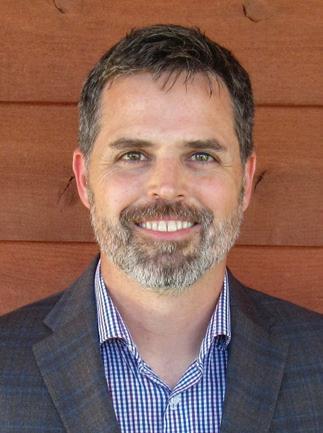Ruralite
BLACHLY-LANE
FEBRUARY 2025

Emergency Preparedness Expertise Page 4
Apply for a Blachly-Lane Scholarship Page 25











































BLACHLY-LANE
FEBRUARY 2025

Emergency Preparedness Expertise Page 4
Apply for a Blachly-Lane Scholarship Page 25










































February 2025 • Volume 72, No. 2
CEO Michael Shepard
SENIOR VP OF CONTENT Leon Espinoza
EDITORIAL DIRECTOR Chasity Anderson, CCC
DEPUTY EDITORIAL DIRECTOR
Noble Sprayberry
SENIOR EDITOR Jennifer Paton, CCC
ASSISTANT EDITORS Victoria Hampton, CCC; David Herder, CCC; Sable Riley, CCC
ASSOCIATE EDITORS
Valeri Saldanha Rosa, Nina Todea
PUBLICATIONS PRODUCTION SR. MANAGER
Elizabeth Beatty
SENIOR PUBLICATIONS COORDINATOR
Alyssa McDougle
Ruralite (USPS 397-460) is published monthly for members for $5.43 per year, plus postage, by Pioneer Utility Resources Inc., 5625 NE Elam Young Pkwy. Ste. 100, Hillsboro, OR 97124—a not-for-profit Oregon cooperative corporation—to serve the communication needs of 46 consumer-owned electric utilities in Oregon, Washington, Alaska, Idaho, Nevada and California. Preferred periodical postage paid at Hillsboro, Oregon, 97123 and additional mailing offices. © 2025 Pioneer Utility Resources. All rights reserved. Reproduction in whole or in part without written permission is prohibited.
Postmaster Send address changes to Ruralite, 5625 NE Elam Young Pkwy. Ste. 100, Hillsboro, OR 97124-6454
HOW TO CONTACT RURALITE
Subscription services:
Nonmember subscriptions $15 (U.S.) per year; $25 per year (foreign). Prepayment required. Allow 4-8 weeks for first issue. Be sure to identify which local edition you want to receive.
Address Changes:
Utility members, contact your local utility. Subscribers, call us at 503-357-2105 option 3 or email mailingdept@pioneer.coop.
Back issues:
Back issues and extra copies $3. Prepayment required. Supply is limited. Be sure to identify edition, month and year. Call first if ordering back issues to check availability.
To contact Ruralite: Ruralite magazine is published by Pioneer Utility Resources.
P.O. Box 1306, North Plains, OR 97133-1306; 503-357-2105; email: info@pioneer.coop. For more information, visit www.pioneer.coop.
DISPLAY ADVERTISING INQUIRIES
American MainStreet Publications
611 S. Congress Ave., Ste. 504 Austin, TX 78704
800-626-1181 or 512-441-5200

February always has a chill to the air, but it’s also a month brimming with warmth and connection.
As we lean into the spirit of Valentine’s Day, our stories reflect the love and care that bind our communities together— from the joy of making music to the dedication of those nurturing the land and each other.

In a small, historic schoolhouse near Junction City, Oregon, the lively strains of fiddle music fill the air. Thanks to music teacher Amy Burrow, young musicians are discovering the joy of traditional jam sessions.
Amy’s quarterly gatherings, supported by grants, are more than just lessons. They are opportunities to build confidence, creativity and camaraderie. For 14-year-old Sapphire Rain, fiddle music is all about freedom and expression.
“You can do what you want with it,” she says.
What better way to share the love of music than by passing it on to the next generation? You can read more on Page 10.
The idea of sharing knowledge and building connections extends to our feature on University Extension programs. Across the country, these programs empower individuals and strengthen communities.

From helping women in farming gain confidence through Annie’s Project in Idaho to saving lives through the Diabetes Prevention Program in Arizona, Extension offices focus on uplifting people in practical, meaningful ways. Read more on Page 12.
February is a time to embrace moments of connection. Whether it’s a warm meal shared with loved ones, planning a spring garden with a friend or learning something new and sharing that new skill, this month invites us to celebrate the ties that bind us.

Have an idea for a story we should share about your community? Reach me at editor@pioneer.coop.
Chasity Anderson Editorial Director

For supplemental and interactive content, search @Ruralite on your favorite social media sites. Plugged In 6
Close, Page 10
From hands-on farming skills to diabetes prevention, initiatives help America innovate
Spotlight, Page 12
In The Kitchen, Page 16
By Craig Reed
Why do you need an emergency plan?
“Disasters don’t wait for you to be ready,” Lane County Emergency Manager Tiffany Brown says. “Everyone in your household needs to be as prepared as possible for an emergency. When a disaster happens, it could take days to weeks for first responders to reach you. There’s also a good chance your household won’t be in the same place when a disaster happens, so create a plan that covers how to get to a safe place, how to contact others, how to find others if separated and what to do in different situations.”
That message is printed on the front of an Emergency Pocket Plan booklet that Tiffany is more than willing to distribute to anybody who wants to start planning for the big one.
The big one could be a wildfire, storm or landslide that destroys structures, brings down power lines and closes roads for an extended time. Oregon has experienced several of those in recent years.
Or it could be the Cascadia subduction earthquake that’s been forecasted for many years. Scientists say this megathrust earthquake in the depths of the Pacific Ocean could be of a magnitude of around 9 and would create a large tsunami. The result would be devastation along the West Coast. One belief is the quake and the surging water would destroy everything west of Interstate 5.
Oregon is considered by scientists to be one of the most earthquake-prone areas in the continental U.S. The largest earthquakes in Oregon’s recorded history—since 1841—were two magnitude 6.0 quakes that hit the Klamath Falls area in 1993. Although the coast line gets most of the attention, inland areas can also suffer.
Devastating events are likely to leave many people, their pets and livestock stranded. First responders may be unable to reach them for many days because of blocked or destroyed roads and bridges.

The scenario may be discouraging, but officials say people in impacted areas can survive through readiness and preparedness.
To help counties and their citizens to plan for any type of major disaster, the Oregon legislature mandated in 2003 that each county have an emergency management manager and staff. The 9/11 terrorist attacks on the U.S. in 2001 led to this mandate.
Tiffany, a native Oregonian who has heard about the Cascadia Subduction Zone since her youth, has been involved in emergency management for 15 years, first in Clatsop County in Northwestern Oregon and now in Lane County. She earned an English degree from the University of Oregon in 1991 and uses her writing and communication skills to encourage people to plan for major disasters.
“This job is well suited to both my skills and my personality traits,” Tiffany says. “I’m an extrovert. This job is largely about coordination and communication. What is gratifying to me is being able to bring people together to coordinate resources and ideas in order to take community resilience to the next level.”
She is also the chairperson of the Oregon Seismic Safety Policy Advisory Commission, a group that was formed following the 1989


“Disasters don’t wait for you to be ready. Everyone in your household needs to be as prepared as possible for an emergency.”
-LANE
California earthquake that registered a magnitude of 6.9 and resulted in 63 deaths and thousands injured and displaced.
“It’s all about preparedness,” she says. “I have the responsibility to maintain operational readiness for the county’s emergency operations center.”
Tiffany says having a plan and access to readiness programs can ease the emotional stress brought about by a disaster and create a path to recovery.
A plan includes having a grab-and-go bag when evacuation is necessary. For years a three-day pack was considered best, but now Tiffany plans for two weeks because storms are lasting longer and because of the Cascadia earthquake threat.
“First, plan for food, water and shelter,” she says. “Second is emotion. This piece may be as important if not more important than physical peace. You need to have an understanding of how you’re going to get information because traditional media sources may not be available. Learn about alternate sources and rely on solid sources for information.
“And the last thing, consider how to combine resources to help one
another in your immediate community on that really bad day,” she says. “An earthquake is going to create devastation for an extended duration. It’s going to take time for first responders and resources to arrive, so turning to help one another is important.”
Tiffany says cellphone calls may not go through in the early stages of an event, but texts might work. She also says a person in an unaffected region or state might be able to take cellphone calls and provide communication for people in an impacted area.
“It’s a great challenge for us to get people ready,” she says, noting the wildfires of recent years, the ice storm early this year and the earthquake threat.
Starting in 2025, the emergency management staff is implementing a regular emergency training calendar for the county and its partners.
Tiffany says the occasional, short power outage is a good time to practice their preparedness for extended outages and devastation.
“You need to know how to navigate without transportation and with no power,” she says. n
Visit tinyurl.com/5bvaxuku for more information on emergency management and preparedness.
Increasing need for power affects electric utilities and their consumers
By Scott Flood
When rural electric utilities first strung power lines from farm to farm, across waterways and through remote forests less than a century ago, most consumers had but a handful of light bulbs to power. With time, they added appliances like refrigerators, but they surely couldn’t imagine the number and variety of electrical devices in today’s homes and garages.
Across the United States, consumers use a growing amount of electricity at work, at home and, with the growth of electric vehicles, on the road.
The demand for electricity increased by 2.5% in 2024 and is expected to grow by 3.2% this year. This comes after many utilities saw a 4.8% increase in 2022. Through 2029, the nation’s peak demand is projected to grow by 38 gigawatts. That would be like adding another Californiasized state to our nation’s power grid.
Driving this surge are advancements in technology, including artificial intelligence, cryptocurrency and cloud computing, which rely on energy-intensive data centers. These facilities, often located in rural areas due to affordable land and fewer neighbors, require massive amounts of electricity.
According to the U.S. Department of
Energy, data centers consume up to 50 times more energy per square foot than traditional commercial buildings. By 2030, these centers are expected to account for 9% of the nation’s electricity use, up from nearly 2% today. A single large data center may demand more than 100 megawatts of power, enough to supply 80,000 homes.
At the same time, baseload power—the always-available energy typically generated by coal and nuclear plants—is being retired at a rapid pace. More than 110 gigawatts of this reliable power are slated to disappear by 2033. As renewable energy sources like solar and wind grow, they cannot fully replace baseload generation due to their intermittent nature. Without sufficient baseload power, the risk of rolling brownouts and blackouts increases, a scenario experts warn could affect 19 states by 2028.
This growth in demand is unprecedented. A decade ago, a huge commercial project might boost a utility’s total load by 20 or 30 megawatts.
“Now, they’re getting requests for projects in the hundreds of megawatts,” says Stephanie Crawford, regulatory affairs director for the National Rural Electric Cooperative Association.
This growth places immense pressure to expand capacity and upgrade infrastructure.
To address these challenges, the efforts fall into two categories: increasing knowledge and building relationships. A generation ago, power supply discussions were fairly straightforward for utility directors, given the widespread availability of baseload generation. Today’s directors increasingly find themselves learning about
sophisticated and challenging issues as they weigh decisions affecting operations and financial viability for years to come.
They must grapple with complex energy issues, from ensuring sufficient transmission capacity to understanding regulatory hurdles. Supply chain constraints also pose significant barriers, with delays for critical components like transformers stretching up to two years.
Relationship-building is equally crucial. Utilities must engage early and often with companies planning large energy projects to ensure alignment on costs, timelines and infrastructure needs. For instance, phased development of a data center can give them more time to prepare for peak loads. Partnerships to develop on-site generation assets may also alleviate transmission challenges.
While these tech companies are often willing to invest in infrastructure upgrades, their focus is on reliability rather than cost. Utilities must balance these demands with their obligation to maintain affordability and reliability for all consumers.
In addition to preparing for new projects, Stephanie notes the importance of leaders keeping their fingers on the pulse of their existing commercial accounts.
“Being proactive and reaching out to understand how a commercial account’s energy needs may be changing in the coming years will inform conversations and decisions about timing, rate design and other factors, even if they’re not making specific requests yet,” she says.
Stephanie says this improved communication helps utilities serve emerging needs while protecting reliability for all consumers. n
After decades of flat or declining electricity demand, the United States is in the midst of a boom in power use. Recent government data shows power consumption nationwide is set to increase by at least 38 gigawatts between now and 2029. This trend would ordinarily be great news for the power industry. But government policies aimed at shutting down fossil fuel-based generation and yearslong delays in permitting and siting for new transmission lines are turning this power boon into a capacity crisis. Here are the primary demand drivers:
Electrification
Electric vehicle adoption, electrification of home heating and industrial electrification are expected to increase overall U.S. energy consumption by 1% per year through 2026.
Economic Growth
Driven by explosions in artificial intelligence, cryptocurrency and cloud computing, total U.S. data center load is projected to increase by 65% by 2050.
Residential power consumption is expected to increase by 14% to 22% through 2050 due to increases in population and steady economic growth.
New, expanding and “onshored/reshored” manufacturing capacity driven by federal incentives is expected to increase industrial demand by 13,000 GWh per year. Key products: EVs, batteries, semiconductors, solar power components
Analysts predicted in 2023 that U.S. peak demand will increase by at least 38 GW over the next five years, nearly double the growth rate predicted in 2022.

By Pam Stevens
Picture this: It’s a dark and stormy night in Blachly-Lane territory, and the power’s out. Your phone flashlight is your new best friend, and you’re wondering how to keep your family warm. Suddenly, in the distance, you see them—the superheroes of the grid—our electric lineworkers.
But here’s the deal: This isn’t the time to turn into an overcurious bystander. For everyone’s safety, it is best to let them do their work.
Electricity is no joke. Lineworkers are trained to handle dangerous situations, but they can’t do their job efficiently if they’re distracted by folks wandering too close. It’s not just risky for them—it’s risky for you, too. High-voltage equipment isn’t forgiving, and the safest place for you during an outage is far, far away from the action. As special as each of our members are, you are no exception to this rule.
We know it’s tempting to walk up and ask what’s going on. But trust us, lineworkers already have enough on their plates. Every minute spent explaining what’s happening is a minute they’re not fixing the problem. Instead, always report your outage on SmartHub or by calling 541-688-8711, then stay informed through
the outage map on Blachly-Lane’s website and our Facebook page. For large or extended outages, updates are provided as new information is available.
In extreme situations, members may receive text, email and/or telephone notifications and alerts. To receive these notifications and alerts, make sure the co-op has your updated contact information for all the ways you wish to receive updates. Updates can be done on the SmartHub app or by calling us during office hours at 541-688-8711.
The fewer distractions, the faster the power comes back on. By keeping your distance, you’re not just staying safe—you’re helping your whole community get their power restored quickly. Think of it as your way of contributing to the effort without needing a hard hat.
Blachly-Lane lineworkers are top-notch pros dedicated to your service, and we know you want to thank them for their hard work. Do so with a wave from a distance or leave a note on our Facebook page. They’ll appreciate the gesture without worrying about rescuing you near a live wire and having concern for their own safety.
So next time the lights go out, remember: Stay safe, stay informed and let the pros handle it. Your cooperative—and your community—will thank you. n


























American Gold Reserve is releasing Government issued $5 Gold American Eagles completely free of dealer mark-up for only $299 each. These beautiful $5 Gold American Eagles are a perfect way to enter the gold market. They are set for immediate public release and will sell out fast.










Story and photos by Mike Teegarden
The distinctive ring of fiddle music fills the small, one-room 1888 schoolhouse near Junction City, Oregon, as musicians tune up and prepare to jam.
But before an outburst of jigs and reels gets toes tapping, a few preliminary instructions from organizer Amy Burrow are in order because this is a jam session lesson.
Amy, a music teacher and fiddler from nearby Eugene, used grants to fund a quarterly jam session for students ages 8 to 18. Her goal is to teach the next generation of fiddlers how to participate successfully in a traditional jam session.
“What I want is that kind of language of knowing 50 to 100 tunes that they can go sit in on a jam almost anywhere in Oregon and call a tune with confidence,” Amy says. “Start it at a tempo that they can manage. Get everybody to play along and know how to finish it.”
The 21/2-hour lesson and jam includes learning new tunes and practicing the etiquette surrounding playing with a group.
Students learn “Dry and Dusty” and “The Snake River Reel.”
The tunes are taught by ear. Amy plays a phrase, and the fiddlers do their best to play it back to her. Once they have a section
down, Amy moves on to the next until the music reaches their fingers.
The real fun begins once notes are memorized. Now, the musicians are free to add their own flair to the tune. They may slide certain notes or add staccatos—quickly played notes—or use other fiddle techniques that add character to the music.
Sapphire Rain, 14, from Monmouth, Oregon, has played fiddle for about two years. She loves fiddle music because the structure allows her to experiment.
“It’s the freedom,” she says. “You can do what you want with it. I have always wanted to play fiddle since I was 4 or 5.”
Tristan Lulay, 15, from Scio, Oregon, loves the feeling of a large group playing together.
“When everyone is playing, it all comes together,” he says. “Even if everyone isn’t a great player.”
Old-time fiddle music is perfect for dancing, so students set down their instruments and pair up for a circle dance as the adult musicians play. The simple circle dance uses moves common to square dancing to mix and move the dancers around the room. It ends with the dancers raising their hands in the center together with a loud whoop and big smiles. n








FROM
Sapphire Rain keeps a close eye on her instructor as she learns a new fiddle tune.
take a break from playing to dance. From left,
Leo
play along with the group. Anna Vane concentrates during class. Amy brings a lot of energy to the class as she teaches the students how to play in a jam session. The 1888 schoolhouse is a fitting setting for old-time fiddle music.




By Ginger Meurer
When Emily Black and her husband, Luke, started farming, they needed help.
“I went to the library and got every single farming book I could find, but that only takes you so far,” Emily says. “Then, there’s YouTube channels that you’re following, but they’re so generic. What about my area? What about my soil?”
To find those close-to-home answers, Emily turned to Annie’s Project at the University of Idaho Cooperative Extension.
Extensions services spread the mission of land-grant universities beyond campuses, reaching out to residents of all ages across America. Educational opportunities provided by extension services cover a wide range of topics, such as helping farmers grow crops and livestock, educating adults about gardening and health, and teaching youth hands-on skills.
University of Idaho Extension educator Colette DePhelps says Annie’s Project courses help women farm operators gain skills, manage risks and build professional networks. While participants have met in person in the past, recent sessions have been virtual—three hours weekly over 12 weeks.
Classes are structured to accommodate the realities of life.
“We know you are multitasking, and it’s fine,” Colette says. “It’s fine if your kids are on Zoom. It’s fine if you have to step away and come back. We totally understand. We’re a very welcoming class.”
Participants come from all scales of operations.
“Newer farmers are learning from farmers who have been farming for a long time,” Colette says. “But also, newer farmers have a different perspective, and they may be more comfortable with technology or direct marketing, so they have fresh ideas to share with more experienced farmers about reaching modern clientele.”
That was the case for Emily, who now teaches marketing strategy through the extension and offers one-on-one coaching through cultivatingyourmarket.com.
Annie’s Project is only one of a wide variety of courses offered through extensions. While 4-H youth development programs and

Master Gardeners community gardening experts are well known, extensions across the country lead a host of other projects they’re excited about.
In Twin Falls County, Idaho, extension educator Siew Guan Lee leads Kids in the Kitchen, a live online cooking program co-launched with the University of Georgia Cooperative Extension in 2020.
“One of the goals is that kids are the chef, and they’re making the meal for the family that night,” Siew says.
She started out offering kid-trusted basics with healthy twists, such as baked chicken nuggets and mac and cheese with broccoli. Participants encouraged Siew to embrace diverse dishes, including offerings from Mexico, Japan, Hawaii, Thailand, Ireland and more. Inspired by a colleague in Georgia, Siew also offers Southern dishes.
“And, of course, we’re Idahoans,” she says. “So, potatoes. We have to have that featured.”
Though the program is intended for Idaho residents, Siew says children log in from Wyoming, Washington, Utah, Oregon, Colorado, California and even Canada. And they aren’t just learning nutrition and food prep skills. They’re bonding with their sous-chef parent assistants.
“Parents said in their feedback that it actually improved their family dynamics,” she says.
Getting families involved in nutrition education was also one of the goals behind Washington State University-Chelan and Douglas Counties Extension’s Story Walk.
Extension director Margaret Viebrock says they teamed with Friends of the Library to select and dissect oversized nutritional picture books. They mounted pages on foamcore with English on one side and Spanish on the other, then took them on the road.
The first book was, “I Will Never Not Ever Eat a Tomato,” which was set up at the Master Gardeners’ Tomato Gala, an annual sample fest where the community votes on which tomato varieties the Master Gardeners grow for the spring plant sale.
The story walk was a hit with families strolling through, reading and collecting prizes after a quiz at the end. The project won a regional award and has been duplicated in half a dozen other extension offices in the state.
The extension also teaches nutrition basics in schools so children “understand that food doesn’t come from the back of a grocery store,” Margaret says. “There’s actually a farmer out there who grows it.”
The mission continues in community gardens, where aspiring green thumbs of all ages can rent small plots for the summer with water, seeds and a few starter plants included.
Lessons get serious when it comes to food preservation. It’s not like baking cookies, Margaret explains. If you’re out of chocolate chips and you substitute raisins, it’s still a cookie.
“With canning and preserving food, you just can’t make a substitution and put it in a sealed jar and expect it to be safe,” she says. “Just because it’s on the internet doesn’t mean it’s right. It’s important to know the source of a recipe to make sure it’s safe to use.”

Saving lives is at the core of the Diabetes Prevention Program that University of Arizona Extension specialist Vanessa da Silva directs. The 12-month intensive course is targeted not at the 1 in 10 Americans who have diabetes but at the 1 in 3 who are prediabetic.
“We use the image of an iceberg,” Vanessa says. “What you can see above water are the people with diabetes. Underwater is this huge number of people that, if nothing changes, are very likely to progress to Type 2 diabetes. We’re trying to have an impact on that through extension.”
Participants in groups of 10 to 20 meet for 26 one-hour sessions over 12 months, starting weekly and easing toward monthly at the end. Lifestyle coach facilitators lead the sessions, but participants are encouraged to get involved.
“We really try to get people to work together and figure out for themselves,” Vanessa says. “What are the changes that they can make?”
Alfred McDonald of Tucson, Arizona, says he had “zero knowledge about diabetes” when he signed up for the program.
“I immediately started learning things out of the gate, like how to read a food label, carbohydrates, proteins, things like that,” he says.
Alfred lost 60 pounds, brought down his blood sugar and learned to manage his stress.
Southern Nye County Extension educator Hayley Maio says her extension operates in an area short on youth programs.
“We focus a lot on 4-H and positive youth development programs to help fill that gap,” she says. “It’s really fun to work with the kids and see them learning and blossoming.”
Tapping volunteers with expertise in a variety of backgrounds, the Southern Nevada extension gives youngsters a taste of robotics, creative writing, art, sewing, baking, gardening and more.
“Whatever kids are looking for or their parents think might be of interest to them, we try to make it happen,” Hayley says. "I’m a firm believer in if somebody wants it, we can figure out how to make it happen. If you can dream it, we can do it.”
Southern Nye County’s Master Gardeners and other adult programs have found success with online education, but when it comes to 4-H, in-person is vital “because it’s a learn-by-doing, experiential learning, hands-on type of program,” Hayley says.
In Washington, Whitman County Extension Office Acting Director Michael Gaffney says if he had to pick just one program he’s excited about, it would be 4-H robotics. He says the program is a science, technology, engineering and mathematics—or STEM—recruitment tool for student engagement in the sciences.
Regional and national competitions are great, but Michael says the real proof of the program’s success is watching kids head off to college to study things like engineering.
“For us, that checks all the boxes for 4-H,” he says.
Life on the Tundra
Hands-on education is so important to the Bering Strait Region Cooperative Extension that students are flown in three to four times a year for the High Latitude Range Management Program—an offering assistant professor Jackie Hrabok says is among the extension’s coolest.
The Western Alaska extension serves residents of Nome and 15 Alaska Native villages in the surrounding 36,000 square miles. Most of the area’s population is Inuit, living in villages off the road system across the Seward Peninsula.
Students learn to manage free-range reindeer that live alongside musk ox, caribou, arctic and red foxes and grizzly bears. They learn how many animals can survive on the rangeland, their preferred diets and how to prevent illness in the animals.
“Interactions between people and animals and the land is all part of the hands-on experience in the classroom and in the field doing field work and learning what type of techniques are used currently to monitor animals and the health of the land,” Jackie says.
The extension also taps the talents of community elders who take students out in the summer and prepare them to learn about plants by having them close their eyes.
“We will taste all the leaves of a variety of species of plants on the tundra,” Jackie says.
Food preservation lessons are also vital as communities deal with seasonal shortages. Jackie explains what changes in weather or delays in supply flights can mean.
“Your little village grocery store, quite often, might not be stocked with the nutrition that you seek,” she says. “So, you go on the land and in the waters, and you bring it home.”

Unlike other extensions tied to a single land-grant college, the University of California’s system taps talent and resources across all 10 University of California campuses while operating as its own entity. Brent Hales, associate vice president for research and cooperative extension, says extension advisers are on the ground throughout the state engaging with local governments, businesses, nonprofits and communities.
The extension operates nine research farms stretching from its borders with Oregon to Mexico. Newer agriculture projects step into the future with drones and robotics.
“We’re investing a lot of time, effort and resources into technology transfer and working with growers and companies to develop cutting-edge technologies,” Brent says. “We’re working with different community colleges and universities to engage both college and high school students in robotics competitions specifically designed to do workforce development to help kids see that they have a great future in agriculture, and they may not touch the dirt at all other than walking on it.”
The extension is also part of a disaster preparedness and resilience team launched in October to face “fire, flood, drought, you name it, climate, heat, human pandemic, animal pandemic, a whole litany,” Brent says.
Cooperative extensions provide practical resources and education, helping communities solve real-world challenges. Whether teaching kids to cook, supporting farmers or preserving local traditions, these programs build stronger, more resilient communities for the future. n
Visit extension.org/find-cooperative-extension-in-your-state to find the cooperative extension in your state.
Latin, Greek, rhetoric, history and mountains of memorization were all elements of the classical university education available to only an elite few Americans before the Civil War. Then, the nation’s education mission expanded on a path that resulted in the cooperative extension network.
X The Land-Grant College Act of 1862, called the Morrill Act for its sponsor, U.S. Rep. Justin Smith Morrill of Vermont, granted each state 30,000 acres of western land for each of its congressional seats to expand access to college education.
X In 1890, the second Morrill Act expanded the land-grant university funding system to the southern states. Native American tribal colleges were added with the Equity in Educational Land-Grant Status Act of 1994.
X In 1914, Congress passed the Smith-Lever Act, which established the Cooperative Extension Service. At the time the act was signed, more than 50% of the U.S. population lived in rural areas, and 30% of the workforce was engaged in farming, according to the United States Department of Agriculture.
X Today, roughly 17% of Americans live in rural areas. University extensions have offices in or near most of the country’s approximately 3,000 counties.

BY NATALIA
Collard Greens With Bacon
2 pounds collard greens
4 thick-sliced bacon strips, chopped
1 cup chopped onion
4 cups chicken stock
1/2 teaspoon garlic powder
1/4 teaspoon salt
1/4 teaspoon crushed red pepper flakes
Trim thick stems from collard greens, and coarsely chop leaves. In a Dutch oven, saute bacon for 3 minutes. Add onion. Cook until onion is tender and bacon is crisp, about 8 to 9 minutes. Add greens. Cook just until wilted. Stir in remaining ingredients. Bring to a boil. Reduce heat, and cover. Simmer until greens are tender, about 45 to 50 minutes.
3 Italian mild or hot sausage links, sliced
1 medium onion, finely chopped
4 garlic cloves, minced
11/2 teaspoons minced fresh thyme
1/2 teaspoon crushed red pepper flakes
2 tablespoons olive oil, plus extra for drizzling
64 ounces chicken broth
1 cup water
4 cups chopped fresh kale
15-ounce can cannellini beans, rinsed and drained
9 ounces refrigerated cheese tortellini
Freshly grated Parmesan, for garnish
In a large saucepan, cook the sausage, onion, garlic, thyme and pepper flakes in oil until sausage is no longer pink. Drain. Add broth and water, then bring to a boil.
Stir in kale and beans. Return to a boil, then reduce heat. Simmer, uncovered, until kale is tender. Add tortellini. Simmer, uncovered, for 7 to 9 minutes or until tender. Serve drizzled with olive oil and freshly grated Parmesan cheese.
2 extra-large egg yolks, at room temperature
2 teaspoons Dijon mustard, at room temperature
2 teaspoons chopped garlic
10 anchovy fillets
1/2 cup freshly squeezed lemon juice, at room temperature
1/2 teaspoon freshly ground black pepper
2 teaspoons kosher salt
11/2 cups good-quality mild olive oil
1/2 cup freshly grated Parmesan cheese, plus extra for garnish
1 tablespoon salt
8 cups broccoli florets, stems removed
1 bunch baby kale
5-ounce bag croutons
Place the egg yolks, mustard, garlic, anchovies, lemon juice, ½ teaspoon pepper and 2 teaspoons salt in the bowl of a food processor fitted with the steel blade. Process until smooth. With the food processor running, slowly pour the olive oil through the feed tube, and process until thick. Add the cheese, and pulse three times to combine. Bring a large pot of water with 1 tablespoon of salt to a boil. Fill a bowl with ice water. Add the broccoli to the boiling water, and cook for 4 minutes. Remove the broccoli with a slotted spoon, and transfer to the bowl of ice water. When it is cool, drain well and transfer to a large bowl. Remove and discard any hard ribs from the kale. Stack the leaves on top of each other, and thinly julienne them crosswise. Add to the bowl with the broccoli. Add enough dressing to moisten the broccoli and kale. Toss well. Add the croutons, and garnish with extra Parmesan.
6 boneless skinless chicken thighs (about 11/2 pounds)
1/2 teaspoon seasoned salt
1/2 teaspoon pepper
11/2 teaspoons olive oil
4 shallots, thinly sliced
1/3 cup white wine or chicken broth
10 ounces fresh spinach
1/4 teaspoon salt
1/4 cup sour cream
Sprinkle chicken with seasoned salt and pepper. In a large nonstick skillet, heat oil over medium heat. Add chicken. Cook until a thermometer reads 170 F, about 6 minutes on each side. Remove from pan, and keep warm.
In the same pan, cook and stir shallots until tender. Add wine, and bring to a boil. Cook until wine is reduced by half. Add spinach and salt. Cook and stir just until spinach is wilted. Stir in sour cream. Serve mixture with chicken.
4 slices pancetta, chopped
2 tablespoons olive oil
1/4 cup chopped onion
2/3 cup cherry tomatoes, halved
1 teaspoon minced fresh rosemary
1/4 teaspoon salt
1/4 teaspoon pepper
2 15-ounce cans cannellini beans, rinsed and drained
3 tablespoons red wine vinegar
4 fresh basil leaves, thinly sliced
2 cups torn fresh arugula
1/4 cup shaved Parmesan cheese
In a small skillet, cook pancetta over medium heat until crisp, stirring occasionally. Remove with a slotted spoon, and drain on paper towels.
In the same pan, heat oil and pancetta drippings over medium heat. Add onion. Cook and stir 1 to 2 minutes or until tender. Add tomatoes, rosemary, salt and pepper. Cook 2 to 3 minutes longer or until tomatoes are softened. Cool slightly.
In a large bowl, combine beans, tomato mixture, pancetta, vinegar and basil. Add arugula and cheese. Toss to coat.
Free to an appreciative home. Almostcomplete sets of “Idaho Magazine” years 2018-24. Pick up at my address in Idaho or by arrangement in Netarts, Oregon. Will ship by UPS if prepaid.
Jim Fazio 1049 Colt Road Moscow, ID 83843
Looking for used postcards featuring the greater Bend/Central Oregon area with writing on the back. These likely would have been from people visiting the area and mailing postcards to friends or family in other parts of Oregon or other states. Thank you.
J. Stephens 19110 Buck Drive Bend, OR 97703
Please help with a legacy artwork of black and white photography portraits for my art project. I will email you a photo of the final. I don’t have any photos of family, so anything will be appreciated. I’m a hobbyist, not a professional photographer.
NJ Bittick 1009 Orchard St. Susanville, CA 96130
I have many used greeting and Christmas cards and a surplus of wrapping paper. If anyone would like to have some of these for a project, I will help with shipping.
Tam Judy 456714 Highway 95 Careywood, ID 83809 jslashbrand@gmail.com
Our father, Marvin, will celebrate his 89th birthday in February. When he was in his 20s, he was stationed with the Air Force in Alaska and never left. He has been in Alaska for over 65 years, worked for the FAA, owned a construction company and enjoyed years of wilderness adventures. Please send to, Marvin Hassebroek, 518 Slater Drive, Fairbanks, AK 99701
Melanie Hinzman Fairbanks, Alaska
Our wonderful grandmother Marian celebrates 100 years in February. Longtime residents of Brookings-Harbor will remember her beautiful smile and gracious presence working at her in-laws mercantile, Hanscam's Store, following her move to Oregon from Kentucky with her Fort Knox soldier after the war. She still attends mass and bakes a terrific cookie. If you care to send a card, poem, cookie or bar recipe, recollection, postcard, etc., to her c/o of me, I'll be sure to deliver them on her birthday. Thank you in advance for sending cheer.
Marian, c/o Cora Rose P.O. Box 490 Brookings, OR 97415
My father-in-law, Elisardo “Alex” Camarillo, will turn 100 in February. Alex was raised in Southern California and served in World War II as a Private First Class from 1942-1945. After the war, he returned to Southern California working on some of the large ranches, such as the Rancho Santa Margarita. He learned to train horses and also worked as a farrier. He moved to Oregon in 1948 and raised his family near Carlton. He continued to work as a farrier until he was 80 years old. It would be wonderful if he could receive cards from you for this special event. Please send cards to Elisardo “Alex” Camarillo, 400 Frank Gilliam Drive, Apt. #15, Heppner, OR 97836.
Sharon Camarillo
Heppner, Oregon
I'm looking for new dinner recipes to add to my family's collection. I would love meals that can be prepared in advance and frozen for later use. If you have a favorite family recipe, please share it with me by email or mail. Thank you.
Stefanie Steward P.O. Box 566 Susanville, CA 96130 stefsteward@gmail.com
Send your request—with no attachments—to readerexchange@ruralite.org or mail to Reader Exchange, 5625 NE Elam Young Parkway, Suite 100, Hillsboro, OR 97124. Fill in the subject line with Reader Exchange. Acceptance, scheduling and editing are at the editor’s discretion. Single requests only, please. No duplicates. Submissions are handled on a first-come, first-served basis and as space allows. We cannot honor every request.
Please affirm you have authorization from all appropriate parties before submitting. By submitting, you indemnify Reader Exchange, Pioneer Utility Resources Inc., its officers, directors, employees, utility clients and insurers from all legal liability incurred by the publication of information.
We no longer accept pen pal requests. You may submit a pen pal request as a Marketplace ad. Marketplace pricing applies.
When submitting a milestone request, please send it at least two months before the milestone.
Phone numbers will not be published. Email addresses will be published if part of the ad, but the request must include a postal address.
Request must include the name and address of the electric utility that provides your magazine.
See bluffs, beaches and history in

Walk into history at Ebey’s Landing National Historic Reserve in the far reaches of Northwest Washington. The reserve, on Whidbey Island near the Canadian border, features unique plants and habitats, tall bluffs that lower into the sea and centuries of historic structures.
First National Historic Reserve
Whidbey Island has been home to many over thousands of years, and, for a long time, was part of the territory of the Lower Skagit tribe. In the mid-1800s, settlers came to the area for the great soil and maritime benefits. In 1978, the area became the United States’ first National Historic Reserve to preserve the natural landmarks and farms that tell the story of rural life.
Ebey’s Landing has more than 30 miles of hiking and biking trails through forests and prairies and along coastline. The Bluff Loop trail and Ebey’s Prairie Ridge trail are popular. Ebey’s Landing is also home to a beach with miles of shoreline, and nearby Crockett Lake is a popular spot for birders during migration seasons.
Inside the reserve are three state parks. Fort Casey State Park is home to a fort built in the late 1800s that was used during World War II and Admiralty Head Lighthouse. Fort Ebey State Park is home to another fort used during WWII and many popular trails. Ebey’s Landing State Park includes the Bluff Loop Trail and many other sweeping viewpoints.
Weather on the reserve is known to change quickly, and quick rainstorms can cause trails to become slick or even cause landslides. The reserve is not all public land—85% of the reserve’s area is privately owned. Please avoid private property. Entering the reserve is free, but entering any of the state parks requires a discovery pass—$10 for a day or $30 for an annual pass. To start planning your trip, visit nps.gov/ebla or call 360-678-6084.
People don’t always do what their doctor says, but when seasoned veteran emergency room physician, Dr. Philip B. Howren, says every senior should have a medical alert device, you better listen up.
“Seniors are just one fall away from being put in a nursing home,” Dr. Howren said. “With a medical alert device, seniors are never alone. So it keeps them living independently in their own home. That’s why seniors and their family members are snapping up a sleek new medical alert device that comes with no monthly bills ever,” he said.
Many seniors refuse to wear old style help buttons because they make them look old. But even worse, those medical alert systems come with
monthly bills.
To solve these problems Universal Physicians, a U.S. company went to work to develop a new, modern, state-of-the-art medical alert device. It’s called “FastHelp™” and it instantly connects you to free unlimited nationwide help everywhere cell service is available with no contracts, no deposits and no monthly bills ever.
“This slick new little device is designed to look like the pagers doctors wear every day. Seniors love them because it actually makes them look important, not old,” Dr. Howren said.
FastHelp is expected to hit store shelves later this year. But special newspaper promotional giveaways are slated for seniors in select areas. ■

■ NO MONTHLY BILLS: “My wife had an old style help button that came with hefty bills every month and she was embarrassed to wear it because it made her look old,” said Frank McDonald, Canton, Ohio. “Now, we both have FastHelp™, the sleek new medical alert device that our grandkids say makes us look ‘cool’ not old,” he said. With FastHelp, seniors never have to worry about being alone and the best part is there are no monthly bills ever.
It’s just what seniors have been waiting for; a sleek new medical alert device with no contracts, no deposits and no monthly bills that instantly connects you to free unlimited nationwide help with just the push of a button for a one-time $149 price tag that’s a real steal after today’s instant rebate
The phone lines are ringing off the hook.
That’s because for seniors born before 1961, it’s a deal too good to pass up.
Starting at precisely 8:30am this morning the Pre-Store Release begins for the sleek new medical alert device that comes with the exclusive FastHelp™ One-Touch E 911 Button that instantly connects you to unlimited nationwide help everywhere cell service is available with no contracts, no deposits and no monthly bills ever.
“It’s not like old style monitored help buttons that make you talk to a call center and only work when you’re at home and come with hefty bills every month. FastHelp comes with state-of-theart cellular embedded technology. That means it works at home or anywhere, anytime cell ser
(Continued on next page)

(Continued from previous page)
vice is available whether you’re out watering the garden, driving in a car, at church or even hundreds of miles away on a tour or at a casino. You are never alone. With just a single push of the One-Touch E Button you instantly get connected to free unlimited help nationwide with no monthly bills ever,” said Jack Lawrence, Executive Director of Product Development for U.S. based Universal Physicians.
“We’ve never seen anything like it. Consumers absolutely love the sleek new modern design and most of all, the instant rebate that practically pays for it and no monthly bills ever,” Lawrence said.
FastHelp is the sleek new medical alert device with the best of combinations: a quality, high-tech engineered device that’s also an extremely great value because there are no monthly bills ever.
Better still, it comes with no contracts, no deposits and no monthly bills ever – which makes FastHelp a great choice for seniors, students and professionals because it connects to one of the largest nationwide networks everywhere cell service is available for free.
And here’s the best part. All those who already have an old style monitored medical alert button can immediately eliminate those monthly bills, which is why Universal Physicians is widely advertising this announcement nationwide.
“So if you’ve ever felt a medical alert device was too complicated or expensive, you’ll want to get FastHelp, the sleek new medical alert device with no monthly bills,” said Lawrence.
The medical alert device slugfest was dominated by two main combatants who both offer old style monitored help buttons that come with a hefty bill every month. But now Universal Physicians, the U.S. based heavyweight, just delivered a knockout blow sending the top rated contenders to the mat with the unveiling of FastHelp. It’s the sleek new cellular
embedded medical alert device that cuts out the middleman by instantly connecting you directly to highly trained 911 operators all across the U.S. There’s absolutely nothing to hook-up or install. You don’t need a land line and you don’t need a cell phone. Everything is done for you.
“FastHelp is a state of the art medical alert device designed to make you look important, not
old. Old style monitored help buttons you wear around your neck, or require expensive base station equipment or a landline are the equivalent of a horse and buggy,” Lawrence says. “It’s just outdated.”
Millions of seniors fall every year and spend hours lying on the floor helpless and all alone with no help. But seniors who fall and get immediate help

are much more likely to avoid getting sent to a nursing home and get to STAY living in their own home independently.
Yet millions of seniors are still risking their safety by not having a medical alert device. That’s because seniors just can’t afford to pay the monthly bills that come with old style medical alert devices.
That’s why seniors born before 1961 are rush-
ing to cash in the whopping $150 instant rebate before the 21 day deadline ends.
So there’s no need to wait for FastHelp to hit store shelves later this year because seniors born before 1961 can get it now just by using the $150 instant rebate coupon printed in today’s newspaper before the 21 day deadline ends. If lines are busy keep trying, all calls will be answered. ■
Use the rebate coupon below and call this Toll-Free Hotline: 1-800-330-4294 DEPT. HELP8438
BORN AFTER 1961: You cannot use the rebate coupon below and must pay $299 Call: 1-800-330-9423 DEPT. HELP8438
THE BOTTOM LINE: You don’t need to shop around. We’ve done all the leg work, this deal is too good to pass up. FastHelp with the instant rebate is a real steal at just $149 and shipping and there are no monthly bills ever.
PROS: It’s the sleek new medical alert device that comes with the exclusive FastHelp One-Touch E 911 Button that instantly connects you to free unlimited nationwide help everywhere cell service is available with no contracts or deposits. It connects you to the vast available network of cellular towers for free and saves seniors a ton of money because there are no monthly bills ever making this deal irresistible. Plus it’s the only medical alert device that makes seniors look important, not old.
CONS: Consumers can’t get FastHelp in stores until later this year. That’s why it’s so important for seniors born before 1961 to call the National Rebate Center Hotline within the next 21 days. For those who miss that deadline, the sleek little medical alert device will set you back over $300 bucks.










By Dave LaBelle
Without darkness, I would never know light. I have heard variations of this truth since my youth.
Though we often speak about contrast—the degree of difference between the darkest and lightest parts of an image—there is another form of contrast that emphasizes the variances between subjects in a composition. And while, generally, we want a photograph to have good tonal range, compositionally, contrasting subjects can also be important for storytelling impact.
For instance, positioning someone tall next to someone short in the same frame helps show the height differential. The same goes for the contrast of a man dressed in an expensive, tailored suit passing by a man partially clothed in soiled rags, communicating the different place in life each occupies.
Henry Cartier-Bresson’s photographs of children playing in war-torn ruins or children pushing a steel hoop down the street as a hearse passes behind them and Margaret BourkeWhite’s 1937 Great Depression image of hungry people in a breadline as a billboard behind
them shows a smiling family in a nice car are examples of iconic photographs employing the concept of contrast.
Of the tools in a writer’s and photographer’s toolbox, the use of contrast can be a powerful and effective device to quickly communicate ideas and concepts. n

Renowned author, photographer and lecturer Dave LaBelle has captured special moments for more than half a century. For more of his writings, visit davidlabelle.com and bridgesandangels.wordpress.com.
See if you can capture or make a photograph that tells a story by using a contrast of subjects. Consider a still-life composition of objects, such as your child’s baby shoes arranged next to their grown-up shoes. It’s a way of revealing time passed. Or illustrate aging with a photograph of a frisky new puppy crawling over a tired, old dog.
Email your best image (just one, please) with caption information, including an explanation of how it affects you, to gph@pioneer.coop. We may share submissions on our website and social media channels.











































OnMay 18, 1980, the once-slumbering Mount St. Helens erupted in the Paci c Northwest. It was the most impressive display of nature’s power in North America’s recorded history. But even more impressive is what emerged from the chaos... a spectacular new creation born of ancient minerals named Helenite. Its lush, vivid color and amazing story instantly captured the attention of jewelry connoisseurs worldwide. You can now have four carats of the world’s newest stone for an absolutely unbelievable price. Known as America’s emerald, Helenite makes it possible to give her a stone that’s brighter and has more re than any emerald without paying the exorbitant price. In fact, this many carats of an emerald that looks this perfect and glows this green would cost you upwards of $80,000. Your more beautiful and much more a ordable option features a perfect teardrop of Helenite set in gold-covered sterling silver suspended from a chain accented with even more verdant Helenite.


Helenite Earrings -a $129 valuewith purchase of Helenite Necklace

Limited Reserves. As one of the largest gemstone dealers in the world, we buy more carats of Helenite than anyone, which lets us give you a great price. However, this much gorgeous green for this price won’t last long. Don’t miss out. Helenite is only found in one section of Washington State, so call today! Romance guaranteed or your money back. Experience the scintillating beauty of the Helenite Teardrop Necklace for 30 days and if she isn’t completely in love with it send it back for a full refund of the item price. You can even keep the stud earrings as our thank you for giving us a try.
Stud Earrings (1 ctw)
Helenite Set (5 ¼ ctw) $428* Call-in price only
earrings)




Blachly-Lane Electric Co-op is offering a $5,000 scholarship to one student who plans to attend a trade school. The scholarship is intended to cover a portion of tuition, tools, and books for the qualifying student.
Be a graduating senior or have graduated or earned a GED within the last two years and plan to attend a trade school. Preference will be given to students enrolling in VOLTA Line School or Northwest Lineman College.
Trade programs through community colleges and other trade programs will be considered as well.
Live in the home of a parent or legal guardian who is an active Blachly-Lane member living in Blachly-Lane’s service area or be an active Blachly-Lane member living in BlachlyLane’s service area themselves
Submit the completed application and one original letter of recommendation to Blachly-Lane Electric Co-op by 5:30 p.m., March 21, 2025
If needed, final candidates will attend a personal interview. We will contact you in advance to schedule an interview if this is needed.



Agriculture
4x5 round bales, Meadow Foxtail Orchard Grass. 4x4 Timothy, small square. 208-4354637 or 208-435-4002; nas@cpcinternet.com. 1225
Reinforced custom-sized pond liners (39 cents/sqft). Hay covers, greenhouse covers, any width and length. Truck tarps and more. High puncture and tear strength. Best price guaranteed. Celebrating 43 years in business. www.btlliners.com. 541-447-0712. 0425
Antiques and Collectibles
Buying antiques and collectibles: advertising signs, porcelain signs, gas pumps, beer signs, antique toys, cast-iron coin banks, neon signs and more. Jason, 503-310-3321 or tjabaughman@yahoo.com. 0325
Buying American Indian collectibles, Navajo blankets and rugs, baskets, beadwork, etc. Also, quality paintings of the early Southwest and Americas. Call 760-409-3117 or send photos to amer.ind.baskets@gmail.com. 0225
Books, Magazines and Videos
Book restoration. Bibles, cookbooks, cherished family heirlooms. Beautiful work. We give renewed life, more durable than original, to last for generations. 775-537-7066; salacanstudio@gmail.com. 0225AR Business Opportunities
For sale: successful Northeast Oregon drive-in diner. Union, OR. Owner wishes to retire after 28 years. RMLS #24493530. Walt BrookshireBroker, Oregon Trail Realty, 541-805-8689. $185K. 0325
Tremendous opportunity to own restaurant, bar, liquor store with pull tabs and lotto sales near Fairbanks, AK. Located near university, airport and musk ox farm. Ivory Jacks since 1975. $1.4M; 5.9 acres. Dick: home, 907-455-6666; cell, 907-888-6668; dickells74@gmail.com. ivoryjacksrestaurant.com. 0225
Community Events
Celestial Resonance by Darcy Dolge. Feb. 7March 29, 2025. Art Center East, La Grande, OR. A multisensory exhibit combining art and sound. artcentereast.org. 0225
Equipment and Tools
Fireproof combination lock safe, $300. DR multi trimmer, $300. Kubota tow rototiller, $1.75K. Land pride 4-ft. mower, $800. Ted, 458-910-3727. 0225
Ads 25 words or fewer are $35 a month. An extended ad of up to 35 words is $50 a month. Contact information is included in the word count. Phone numbers and emails count as one word.
Longer ads may be placed. Contact 503-357-2105 or info@pioneer.coop for pricing information.
Ads are for customers of member co-ops, public utility districts and municipals only. Subscribers and nonmembers may inquire about pricing at 503-357-2105 or info@pioneer.coop.
Ads must be direct and in first person, and are subject to approval and editing.
Closing deadlines (in our office): April issue—Feb. 28, 2025.
If submitting ad by mail, send appropriate payment with your name, address, email, phone number and the name of the electric utility that provides your magazine to: Marketplace, P.O. Box 1306, North Plains, OR 97133. Make check or money order payable to Ruralite.
We accept credit card payments for ads submitted by email. Send ad to info@pioneer.coop. Call 503-357-2105 to pay by credit card.
Advertisements are accepted in good faith. Pioneer Utility Resources is not liable for interactions between buyers and sellers.
For Rent, Lease
NE, OR. 1 bd, 1 ba, bonus room. Nice smaller home. Water/sewer/garbage paid. $650 month/plus deposit. 55-plus preferred. Phone calls only. 541-519-3400. 0225
Free Items
Free materials—church, government uniting, suppressing “religious liberty,” enforcing National Sunday Law. Be informed. Need mailing address only. TBS, P.O. Box 374, Ellijay, GA 30540. tbsmads@yahoo.com; 888-211-1715. 0325AR
Livestock, Supplies
28th annual Oft Angus Bull Sale. March 20. Producers sale yard, Vale. Selling 90 fall and 2-year-old bulls. Terry, 208-741-0824, or Colleen, 208-202-8352. 0325
Miscellaneous
Foster parents needed to care for teen youth in Wasco and Hood River counties. Agency provides on-call support, training, $2.1K/youth monthly reimbursement, 2 days off/month. Fosterinfo@nextdoorinc.org; 541-308-2207. 0625
Looking for that special knife? I hand make custom hunting and fishing knives. I also make other metal and woodcrafts. 559-212-0693; Buckeyeknives.com. 0225
Local commercial fisherman sells summer catch of preserved freshness by blast freezing at sea, gourmet canned tuna on internet. Sept.June. 100% guaranteed the best canned tuna you ever tasted. Original, jalapeno and garlic flavors available. To order: twofisherstuna.com or 206-799-1082. 0225
Granite cemetery markers at affordable prices. Will ship to most places. For more info: Joe, highdesertmemorials@gmail.com or 541-815-8906; www.highdesertmemorials.com. Pets and Supplies
Border collie/McNab puppies. The best dog you will ever have. Males and females, $450 each. Colton, OR. 503-314-0145. 0225
$180K. 160 acres, proven gold claims. 131 miles north of Fairbanks, AK. 50-yard-per-hour shaker plan. Complete water system. Text, 907-223-3036. 0225
Let me help you buy or sell ranch, farm and recreation property in OR. Fourthgeneration Oregonian, prior ranch owner. For sale: Klamath Marsh, OR. 173.65 acres. $2.5M. Guest Ranch Overlay. John Gill, 541-480-9161; johngill@landandwildlife.com. Land And Wildlife brokerage. 0225
Dale store. Live/work in a recreational enthusiast’s location, store, fuel, post office, home, game cooler. $325K. Duke Warner Realty, 541-987-2363, ddwr@ortelco.net. 0225
3 beautiful 1.01-acre lots in Pahrump, NV. Awesome mountain view in nice area. No HOA. $30K each or two for $55K. Easy access to off-roading. Horses OK. Also 10-acre lot with water rights and underground utilities. pkcfitness@hotmail.com. 775-209-2830. 0225
320 acres east of Adel, OR. Borders Hart Mountain views, Steens Mountain and Beaty Butte. Landowner tags, very rural. $263K. For maps, contact: 541-659-1573; thejugglingman3@gmail.com. 0225
Recreational Rentals
Bed and Birds; a guesthouse. Wet meadows, range, forest, dark sky. Beds for 9. Lakeview, OR. Explore or ride? Near ski hill. Reasonable. 541-219-2044. 0425
Bend country cabin. Very clean and fully furnished cabin on private ranch. Close to recreation areas. Very nice. $95/night. 541-382-3050; bendcountrycabins@gmail.com. 0325
Wavecatcher: oceanfront cottage. Central Oregon Coast. $175/night (plus cleaning/tax). Open April through Oct. Holds up to 6-plus kids and pets. Wavecatcherbeachrentals.com. Reservations: 541-740-2846. 0325
Dry cabin and bunkhouse rental near Freeman Creek on Dworshak. Fully furnished. Outhouse and outdoor shower. Sleeps 6. No animals. April through Oct. Reservations: DebbieL1213@gmail.com. 0225
Cabin rental in Eagle Lake, CA. 3 bd, $175; summer rate. Memorial weekend-Oct. Winter months: Nov.-Feb.; $225. 3 miles to marina. Reservations, 530-310-5320. 0225 Recreational Vehicles
Thor A.C.E model 27.2, 2017 motor home. Excellent condition. 14K miles, 2 slides. Sleeps 6, 2 TVs, always covered. $60K. debutler1947@icloud.com; 541-953-0295. 0225
24-ft. Sunseeker RV Mercedes. Diesel, 8-ft. slide out with 4-person dinette, sleeps 6. 60K miles, 2016. $48.5K. Ted, 458-910-3727. 0225
2008 Lance truck camper with slide, model number 1181. Fully loaded; excellent condition. Onan generator, solar panel, wooden interior. $15K. Pahrump, NV. 775-990-0028. 0225
Dawn Till Dusk Masonry. Brick, block, stone and pavers. Small jobs and repairs welcome. dawntillduskconstructionmasonry.com. 541-388-7605; 541-410-6945. License #245760 bonded and insured. La Pine, OR. 0225
Writing and grammar coach with 35 years experience teaches students 12 and older. Local hybrid in Manzanita, OR, or all online. $100/class. writingtutor22@gmail.com; Louisapeck.com. 0225
All types of roofing and repairs, family business since 1956 where integrity prevails. Dave, 541-852-2816. Josh, 541-255-6031. 0425
Grandsons want Damon Howatt bow’s and arrows for target and or hunting. Bill Howat, text pictures of equipment: 509-837-8695. Swaps and Trades
Private horse ranch in Sisters, OR, offers an RV spot for your RV living in trade for light horse feeding and cleaning. TK, 541-504-1234. 0225
Old carpenter tools, planes (wood/metal), levels, chisels, slicks, adzes, axes, hatchets, handsaws, old rulers, spoke shaves, wrenches, shipwright tools, old tool chests. 503-659-0009; 971-666-0659. 0225
Gold, silver, coins/currency, buy, sell. Collections wanted. Fair prices paid. 44 years in retail store. Baker City, OR. 800-556-2133; garrymclin@aol.com. 1025
Buying American Indian collectibles, Navajo blankets and rugs, baskets, beadwork, etc. Also, quality paintings of the early Southwest and Americas. Call 760-409-3117 or send photos to amer.ind.baskets@gmail.com. 0225
Cash paid for old gas station and oil company signs, pumps, globes, metal oil cans. Good condition. Discreet cash settlement. Clifton Jones, collector. 512-413-4459. 0225

Nothing brings family together like food, but what are our readers’ favorite dishes? Check out nearly 300 recipes for appetizers, drinks, main dishes and desserts from our 2013 contest. The book is $10 (includes postage).
TO ORDER BY MAIL: Submit payment with cookbook title, your name, address and number of cookbooks wanted to: Ruralite Cookbooks P.O. Box 1306 North Plains, OR 97133
TO PAY BY PHONE: Call 503-357-2105 for credit card payments with Visa, MasterCard, Discover or American Express.
TO ORDER ONLINE: Visit www.ruralite.com.
Please allow two to three weeks for delivery.
Eatonville United Methodist Church A Spiritual Base Camp On The Way To Paradise. Mashell Avenue North P.O. Box 205 Eatonville, WA 98328 360-832-4021 Home: 360-832-4562 Pastor Bernard Preston Ritchea Cell: 361-330-9666
Facebook: Eatonville United Methodist Church of Washington OPEN HEARTS OPEN MINDS OPEN DOORS OPEN TABLE WORSHIP SERVICE BEGINS AT 10:30 a.m.
By Pam Stevens
When it comes to your electricity service, understanding where Blachly-Lane Electric Co-op’s responsibilities end and yours begin can save you time, money and frustration. For electric utility customers, the boundary of responsibility is the meter—an essential component of your power supply.
Let’s break down the roles of utilities and members, explore how to maintain equipment on your side of the meter, and highlight the benefits of increasingly common smart meters, which are the next generation of meters Blachly-Lane deploys in the future.
The Utility’s Role: Up to the Meter
Blachly-Lane Electric Co-op is responsible for delivering power to your home. This includes maintaining the infrastructure that brings electricity from power plants to your neighborhood.
X Power lines and poles: Utilities maintain and repair the lines and poles that carry electricity to your area.
X Transformers: These devices adjust voltage levels to make electricity safe for household use.
X Service drop: The line that connects your home to the utility’s distribution system is maintained by the utility company up to the meter.
X Electric meter: Meters measure the electricity you use to provide you with an accurate bill for your service. This device is installed and owned by the utility, and we handle any repairs or replacements needed.
Consumer’s
Once electricity passes through the meter and into your home, responsibility shifts to you, the member. Everything on your side of the meter—commonly referred to as behind the meter—falls under your care.
X Service panel, also known as a breaker box: This distributes electricity throughout your home and protects circuits from overloads.
X Wiring: All electrical wiring inside your home, including connections to outlets, light fixtures and appliances, is your responsibility.
X Outdoor equipment: If you have member-owned outdoor lighting, electric fences or other equipment, these systems must also be maintained by you.
Proper maintenance of this equipment is crucial for safety and reliability. Faulty wiring or neglected equipment can lead to power outages, electrical fires or damage to appliances.
To avoid potential problems, regular maintenance is key
X Inspect your wiring: Have a licensed electrician inspect your home’s wiring periodically, especially in older homes.
X Check your breaker box: Ensure the service panel is clean, dry and free of pests. Replace worn or damaged components promptly.
X Address outdoor hazards: Keep trees and vegetation clear of outdoor wiring, and ensure external electrical connections are weatherproofed.
Being proactive about maintenance protects your home and can prevent costly repairs and disruptions.
Smart meters are revolutionizing how utilities and consumers interact with electricity. Unlike traditional meters, which require manual readings, smart meters use advanced technology to measure and transmit your electricity use data in real-time.
X Faster problem detection: Utilities can quickly detect outages or service issues through smart meter data, often leading to faster power restoration.
X Real-time monitoring: Many utilities provide online portals or mobile apps where you can view your energy use by the hour, day or month. This helps identify high-use periods and helps you adjust habits to save money.
X Customized billing: Smart meters enable time-of-use rates, when electricity costs less during off-peak hours. This can help you save if you shift use to lower-cost times.
X Environmental impact: By using energy more efficiently, you reduce strain on the electric grid and lower your carbon footprint.
Understanding how electricity flows into your home and where your responsibilities begin empowers Blachly-Lane members. It also enhances our partnership as we serve the community.
Regular maintenance of your side of the meter, and smart energy use, can lead to long-term savings and a safer home environment.
Have questions about the health of your side of the meter? Consult a licensed electrician for professional advice. By staying informed and proactive, you can keep the lights on—and your wallet happy. n
This graphic depicts equipment owned by the co-op (in gold) and the member (in blue). If a storm damages any equipment owned by the co-op, we are responsible for repairs. If a storm damages any member-owned equipment, the member is responsible for repairs. Members should hire a licensed electrician when making any repairs to member-owned equipment.
Note:
After seeing the photo we published in September of a fawn and cat, Ron Kopp decided to photograph similar events in his own backyard between a cat and a young buck.
“On our family ranch, south of Pilot Rock, Oregon, it is not unusual for deer to be in the yard—or cats, for that matter,” Ron says. “It is unusual for them to interact, however, especially on the sidewalk that leads to the ranch house’s front door.”
To submit your photo, email a JPEG file to photos@pioneer.coop. Include “Before You Go” in the subject line. Please share a bit about what inspired you to make your photo. n
A cat named Cat lies on a sidewalk as a curious buck leans down to lick it. As Cat placed his paw on the buck’s nose, neither seemed to mind the interaction. PHOTO COURTESY OF RON KOPP
Get more than 220 recipes in a perfect-bound 8½-by-11-inch indexed book for $10, postage included.



of cookbooks wanted, along with your name and address, to Ruralite Cookbooks, P.O. Box 1306, North Plains, OR 97133. BY PHONE: with Visa, MasterCard, Discover card or American Express. The 2008 contains recipes—most and dessert, the heartfelt stories recipes. indexed postage).



The 2008 contest cookbook contains more than 180 recipes—most with a side dish and dessert, too. Included are the heartfelt and entertaining stories that accompany the recipes. The 8½-by-11-inch indexed book is $8 (includes postage).
TO ORDER BY MAIL:
Submit payment with cookbook title, your name, address and number of cookbooks wanted to: Ruralite Cookbooks P.O. Box 1306 North Plains, OR 97133
TO PAY BY PHONE: Call 503-357-2105 for credit card payments with Visa, MasterCard, Discover or American Express.
TO ORDER ONLINE: Visit www.ruralite.com.
Please allow two to three weeks for delivery.
TO ORDER Submit your
cookbooks











Blachly-Lane
Electric Cooperative
90680 Highway 99 N. Eugene, OR 97402
541-688-8711
800-446-8418
blec@blec.coop www.blachlylane.coop
Our Mission: To make continuous and practical improvements in our quest to provide safe, reliable electric service to our community of members.
Board of Directors
District 1
Ernie Jacksch, Secretary/Treasurer 541-927-3466
District1Director@blec.coop
District 2
Kelly Harpole
541-729-0104
District2Director@blec.coop
District 3
Beverly Mattheisen, Chairwoman 541-998-3704
District3Director@blec.coop
District 4
Mary Ann Rhodes, Vice Chairwoman 541-998-2630
District4Director@blec.coop
District 5
Eric Imbler, Director 541-954-1949
District5Director@blec.coop
General Manager
Jeff Jones
jonesj@blachlylane.coop
OR-17
Dear Member,
As you know, last month signaled the dawn of a new Oregon Legislative Assembly, a new U.S. Congress and a new presidential administration. For us, like every odd-numbered year, this is another opportunity to shape policies ensuring your access to affordable, reliable electricity.
The 83rd Oregon Legislative Assembly convened in Salem on Jan. 21, a few weeks after the 119th Congress began in Washington, D.C. Columbia Power Cooperative will have a voice in both capitals through our state and national associations the Oregon Rural Electric Cooperative Association and the National Rural Electric Cooperative Association.

As always, there are several new faces on both sides of the aisle in Salem and two new members of Congress from our great state. Oregon’s electric cooperatives will work hard to build new relationships and continue existing relationships on a bipartisan basis with these important decision-makers.
It is clear that wildfire policy will be an important issue in both Salem and Washington, D.C. The tragic fires last month in Los Angeles confirmed what we already knew: Wildfires can strike anywhere, rural or urban. We will continue to pursue policies that protect our communities from the risks posed by wildfire.
Because federal hydropower marketed by Bonneville Power Administration is such an essential part of our power supply, we will engage with the new administration and the appropriate federal agencies to advocate for a more commonsense approach to hydropower. As the Northwest’s demand for power grows, this is no time to remove an already carbon-free, reliable form of electricity, as some have proposed.
There is no shortage of energy challenges, and I look forward to working with our elected officials to help solve them.
Sincerely,
Jeff Jones General Manager
The board approved the following action items:
h Filing the financial report for audit passed 5-0.
h Accepting Resolution 2024-7 Authorizing Capital Credit General Retirement passed 5-0.
h Approval of the 2025 scholarship in the amount of $5,000 for one applicant carried 5-0.
h The board and member Troy McCrae were appointed to serve on the audit committee, passing 5-0.
h The board reviewed and approved various cooperative expenses. Monthly Policy Review
5-0.